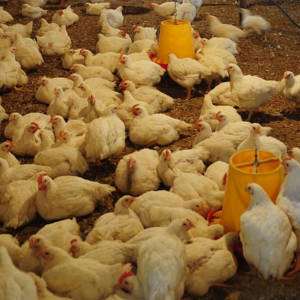Using AI to control energy for indoor agriculture
30 September 2024
Published online 28 April 2016
A public health crisis looms if measures are not taken to quell the misuse of antivirals by some veterinary drug manufacturers.

The irresponsible use of amantadine, an anti-influenza drug, in commercial poultry in China allowed the emergence of drug-resistant mutants among lethal influenza strains, rendering this drug ineffective for treating human infections1.
This left a group of anti-influenza drugs known as neuraminidase inhibitors, including oseltamivir, as the last line of defence for treating clinical human influenza infections. There is evidence of widespread misuse of amantadine in Egypt, the only country in the Middle East where avian H5N1 influenza virus is endemic2.
Genetic analysis revealed evidence of amantadine-resistance in 48% of Egyptian avian H5N1 strains.
The failure of mass vaccination and amantadine resistance has prompted some local investigators in Egypt to explore the suitability of oseltamivir for poultry3. Even if oseltamivir could be effective during an H5N1 outbreak, in light of the regulatory weakness surrounding veterinary pharmaceuticals, irresponsible use is highly likely and would probably lead to drug resistance.
Coupled with the gradual adaptation of Egyptian H5N1 strains to humans, the scenario would be a public health disaster.
The nature of viruses makes them prone to frequent random mutations in their genomes. Unlike antibacterial agents, antivirals usually have a very narrow spectrum and can attack a specific viral target. A mutation affecting this target could render the drug useless, and lead to the emergence of drug-resistant variants.
Drug-resistant mutants emerge as a result of the selective pressure of the drug on a group of genetically related, but not identical viruses. Some of these variants already harbor naturally acquired mutations that would allow them to replicate in the presence of the drug.
Drug resistance is a common clinical problem, so antiviral therapeutic regimens have always relied on drug combinations; HIV/AIDS is a good example. However, the benefit of having multiple drugs is not available in the case of influenza viruses, for which current therapy relies on one group of drugs targeting a protein on the outer surface of the virus, known as neuraminidase (NA). The risk of clinical antiviral drug resistance increases under conditions of immunosuppression, prophylactic use and lack of adherence to medication regimens resulting in suboptimal doses of the drug.
Similar scenarios are also applicable to animals and birds, which creates a challenge for the veterinary application of antiviral drugs.

One of the major challenges facing the poultry sector in Egypt is the wide spectrum of viral infections affecting those birds. Among several other viruses, influenza and herpes viruses make the top of the list of pathogens causing serious economic losses. In particular, zoonotic influenza H5N1 viruses pose a serious threat to human public health. In addition to the widespread outbreaks in commercial poultry, it has caused the largest number of human infections worldwide.
Another significant group of influenza viruses that belong to the H9N2 subtype are also co-circulating with H5N1 viruses and has recently caused human infections.
Many virologists are watching the escalating Egyptian influenza situation very closely because if those viruses mutate further to allow transmission among humans, the scenario would be conducive to a new influenza pandemic4.
Anti-influenza drugs currently available fall into two main groups: M2 blockers (eg amantadine) and neuraminidase inhibitors (e.g. oseltamivir).
M2 blockers interfere with the process of unwrapping the viral genetic material inside the cell upon infection; while neuraminidase inhibitors block the release of newly formed virus particles from infected cells.
Acyclovir, an acyclic nucleoside analogue, was one of the earliest compounds ever developed for treating human herpesvirus infections. It inhibits the herpesviral DNA replication after being metabolized inside infected cells via a virus-encoded enzyme known as thymidine kinase.
Tighter regulations are needed to monitor the manufacturing of Egyptian veterinary pharmaceuticals.
Registration of veterinary pharmaceuticals containing antiviral compounds is not permitted in Egypt. As of November 2014, registration of all pharmaceuticals containing amantadine was totally banned due to their inefficacy in treating human influenza infections5. However, despite these regulations, we identified at least five commercial veterinary products containing amantadine and two others containing acyclovir.
Further investigation revealed that these products are registered with the ministry of agriculture as nutritional supplements for veterinary use, and most likely antivirals could have been added illegally during manufacture. It also came to our attention that the veterinary use of cheap pharmaceuticals registered originally for humans is not an uncommon practice, according to several vets who spoke anonymously to the authors.
In order to evaluate the impact of using anti-influenza compounds in the veterinary field, we analyzed 250 M2 and 481 NA sequences available in databases for avian and human H5N1 isolates collected in Egypt between 2006 and 2015.
About 48% of avian and 10% of human H5N1 M2 sequences displayed genetic markers of amantadine resistance. Our analysis also indicated that these resistant mutants emerged in mid-2007; few months after the putative time of applying amantadine to farmed poultry. Furthermore, a recently published study reported amantadine resistance markers in three contemporary Egyptian H9N2 isolates6. Among 481 available NA sequences for Egyptian H5N1 strains, two avian and three human viruses displayed markers of oseltamivir resistance.
Resistance of animal herpes viruses to antiherpetic acyclic nucleoside analogues could arise quickly in the laboratory7. However, we could not analyze the impact of the field use of acyclovir because only one thymidine kinase gene sequence, which belonged to an avian herpesvirus, was available in the databases.
Despite a handful of viruses showing signs of resistance8, so far, human H5N1 infections in Egypt has been successfully treated with oseltamivir, particularly if administered during the early stage of infection. Yet oseltamivir is a relatively expensive drug. The fact that locally conducted studies are exploring means of making the oral administration of oseltamivir to poultry more cost-effective is alarming3.
All human H5N1 infections since 2009 are caused by a group of viruses with enhanced affinity to bind to the type of receptors present on the surface of human cells. If these viruses acquire resistance to oseltamivir after its large-scale use in poultry, public health will be threatened because we will lose our cornerstone drug for treating humans.
Tighter regulations are needed to monitor the manufacturing of Egyptian veterinary pharmaceuticals.
Amantadine resistance is already widespread, so there is no point in including it in any nutritional supplements used for poultry. Acyclovir is not equally effective against all herpes viruses, and its antiviral efficacy against those types infecting poultry has not been established, therefore its use in poultry is purely empirical and unnecessary. The group of neuraminidase inhibitor compounds, exemplified by oseltamivir, is currently our only asset for treating human influenza patients.
Oseltamivir use in poultry should be banned.
Islam Hussein is a researcher and virologist at MIT, Massachusetts. He is currently involved in several projects focused on identifying, tracking and investigating any genetic changes that might lead to the generation of potentially pandemic influenza strains.
El-Sayed Abdelwhab is a veterinarian and researcher specialised in avian influenza, Based at the Federal Research Institute for Animal Health, Germany, his research aims at understanding the molecular biology of avian influenza viruses as a prerequisite for the development of poultry vaccines.
doi:10.1038/nmiddleeast.2016.49
Stay connected: